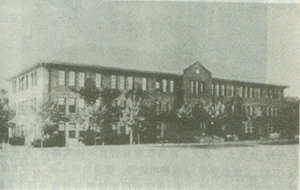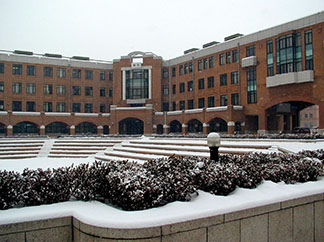About Department of Physics
HISTORY :
Since its foundation in 1926 the Department of Physics at Tsinghua University has earned a reputation as one of best Physics Departments in China. Led by Professor Qi-sun Ye (Ch’i-Sun Yeh), the first department head, this Department recruited several most distinguished physicists in China, including You-xun Wu (Y.H. Woo), A. Pen-Tung Sah, Pei-yuan Zhou (Pei-yuan Chou), and Zhong-yao Zhao (Chung-Yao Chao), and cultivated a large number of outstanding physicists, such as Gan-chang Wang (K. C. Wang), Zhu-xi Wang (C. C. Wang), Huan-wu Peng, Wei-chang Qian (Wei-zang Tsien), San-qiang Qian (San-Tsiang Tsien), Da-heng Wang (Ta Heng Wang), and Chia Chiao Linet al., in early 1930s.

Science Building at early 1920's
In 1937, because of the Japanese Invasion, Tsinghua was forced to move from Beijing to Changsha, Hunan Province, and was merged into the “National Changsha Temporary University” with Peking University and Nankai University. In 1938 it had to move to Kunming, Yunnan Province, again and with its name changed to the “National Southwest Associate University”. In the World War II a great amount of outstanding scholars was educated in the Department of Physics, such as C. N. Yang (Nobel Laureate), T. D. Lee (Nobel Laureate), Kun Huang, Jia-xian Deng, Guang-ya Zhu, et al..
In 1952, this Department dissolved and most of its faculty members and students joined Peking University, because during that time the China’s education system followed the former Soviet Union, and Tsinghua University was designed to be a polytechnic university. Thus the remained and later-recruited faculty members were concentrated on the university-physics teaching for undergraduate students. In 1956 the Department of Engineering Physics aiming at nuclear technology was set up, in which two groups on nuclear physics and theoretical physics were growing.
The Department of Physics at Tsinghua was reestablished in 1982 responding to the demand of modernization and internationalization, and Guang-zhao Zhou (Kuang-Chao Chou), a Physics alumnus and the then President of Chinese Academy of Sciences, assumed the department head. Two years later, the department was entitled “Department of Modern Applied Physics”, and renamed as “Department of Physics” in 1999. Great efforts have been made since the reviving of the Department of Physics. Now it has become one of the most important research centers and physicist cultivating bases in China.
Department of Physics at Tsinghua was proud of its graduates. As one of the most magnificent achievements in the history of Chinese modern education, among 23 “A-bomb”,“H-bomb” and “Satellite” Heros in China, 9 were undergraduates of this Department, including Gan-chang Wang, San-qiang Qian, Huan-wu Peng, Da-heng Wang, Jiu-Zhang Zhao, Fang-yun Chen, Jia-xian Deng, Guang-ya Zhu, and Guang-zhao Zhou, and another Hero, Yong-huai Guo, was also studied in its graduate school. In addition, this Departments have cultivated thousands of scholars, including more than 70 Members of the Chinese Academy of Science, of the Chinese Academy of Engineering , of the NAS of USA, etc..
TODAY:
Situated in the northwest of Tsinghua campus, which is surrounded by a few historical sites in northwest Beijing, is the Science Building of the Physics Department.

Department of Physics, Tsinghua University
Together with the nearby Department of Chemistry, Department of Biology, and Department of Math, the Department of Physics constitutes the School of Science, Tsinghua University.
Among the Department’s most significant resources is its highly respected faculty, including 39 full professors and 39 associate professors. Among them, 10 professors have been elected as the Members of Chinese Academy of Science. Many faculty members have received various international and national awards for their research achievements, such as the National Award in Natural Sciences, Outstanding Youth Scholar Prize from Hong Kong Qiushi Foundation, Alexander von Humboldt research fellow, etc. Fourteen professors are the winners of National Science Fund for Distinguished Young Scholars.
Authorized by the Ministry of Education in 1998, this Department can confer doctoral degree in all sub-fields in physics, including Condensed Matter Physics, Atomic and Molecular Physics, High Energy and Nuclear Physics, Optics, Theoretical Physics, Acoustics, and Plasma Physics. In addition, it is also allowed for this Department to confer the Ph. D degree in Astrophysics.
The guideline of the curriculum is to cultivate first-rate physical specialists who have both plenty of fundamental theory and experiment skills. It is emphasized that the students should be able to catch up with the fast advancing modern physics and related technology, and apply them in different fields. In addition, students who are interested in fundamental physics are specially trained aiming for promotion of corresponding fundamental subjects. Our graduates at all levels have distinguished themselves in academic, industrial, and governmental careers.
The Department of Physics gets grants of values of more than tens million Chinese Yuan each year form State and private foundations, for instance the National Natural Science Foundation, National Key Program of Basic Research Development, National High Technology Research and Development Program, and so on. In recent years, more than 500 research papers are published each year in refereed international, domestic journals and proceedings of international conferences.
There exist broad collaborations between this Department and its counterparts abroad. Every year, a large number of faculty members visit foreign Institutions and participate in international conferences; meanwhile many outstanding scholars all over the world are invited to visit this Department.